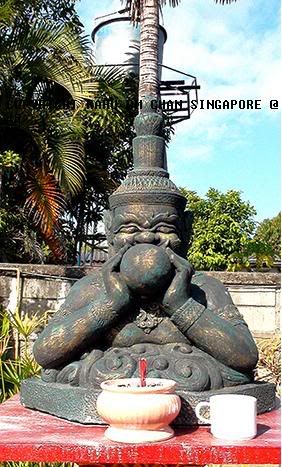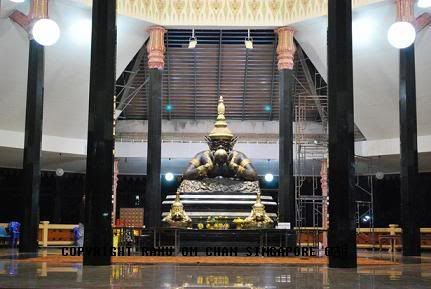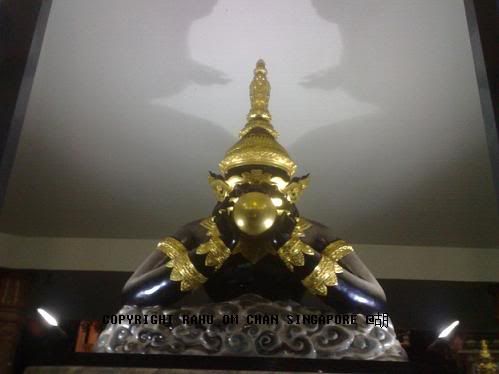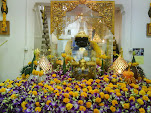Wednesday 30 September 2009
Monday 28 September 2009
Phra Pitha
พระปิดตา(译音)帕必达,其中ปิดตา泰文的意思是闭眼或遮眼的意思 因此可以称之为闭眼佛或是遮眼佛,而泰国的遮眼佛有很多种类型 有双手遮眼的法相,也有四臂、六臂、或是布满经咒文如同皱纹般的法相 都是属於遮眼佛(必达佛),不同的译音只是外在的法相特徵不同而已
而必达佛的佛牌,是泰国民众普遍喜爱佩带的佛牌之一,据说佩带遮眼佛 可以帮信众挡掉很多不好的事情、麻烦、避灾挡险,能够保信众的平安 也能够帮信众招来很多很好的财运,因此必达佛也是泰国的致富佛像之一!
当帕必达在世时,几世之前就已经不断累积很多的福德资粮 。在其中一世,有许多僧侣与帕必达一起修行,结果没想到在某天夜晚时, 发生了洪水,眼看就要将他们灭顶。此时,佛陀赶紧命令帕必达前去 将水阻止不动,以免这些僧侣灭顶。因此当时有许多的天人和凡人们,
都因此信服他的能力,并对他非常敬仰。此外,在帕必达之前的一世中, 他常常用鲜花供养佛陀及许多的高僧。接著帕必达转世在另一世之後, 则生为一户养牛人家的孩子。早晨的时候,他常常看到高僧沿街托钵化缘後, 会在一个空地修行打坐。由於他看到高僧总在烈日下修行,想到这必然非常辛苦, 因此趁高僧不在时,为高僧搭起简单的棚子,让高僧在打坐时可以遮阳避雨, 他也因此累积很大的福德。因此在临命终时,得升天道;但他在生为天人後,
并未耽溺於天道的逸乐,反而常常广行佛事,不断地累积福德资粮。此後, 帕必达的法像就被制作为如今所看到的样子,象徵祂用手将六根遮住, 即眼、耳、鼻、舌、身、意皆被遮止;以免受到这六根所对应到的六尘所扰, 此六尘则为外界的色、声、香、味、触、法,让人能谨记佛陀的教诲。
因此佛子佩带必达佛牌的时候,无论是在修行佛法 或是行事思考之时, 都能够让心念更加全 心专注,提升自己的思考层面;此外,在世俗上, |
Thursday 24 September 2009
Sunday 20 September 2009
Buddha With Sunglass
There is a small shrine in Maha Chai province Thailand, it is about 2 hours drive from Bangkok. The shrine is just next to a very busy fishing port where seamen load and unload their catch daily. There is a story why this particular Buddha is wearing sunglasses.
Luangpor Poo above is one special Buddha in Wat Krok Krak at Samutsakorn Province. The statue of Luangpor Poo actually floated along the large river bank nearby and a shrine was later enacted especally for him. Maha Chai used to be just a small fishing port but has now become a major and important place where business takes place. A man once went to Luangpor Poo and seeked for helped hoping that his life and business would improve. His wish was granted not too long and this faithful devotee actually went back to do thanks giving. He did what any normal devotee would by giving traditional offerings, before he left the temple he was asking himself what else has he not given to Luangpor Poo alas he found that he has a sunglass with him and he put it on the Buddha.I am not sure if this one here is true but someone actually removed the sunglasses from the buddha because he thought that it was disrespectful. Some people said that he became blinded after doing that and he went to replace the glasses back.
Luangpor Poo is also known to grant his devotees wishes qucikly and swiftly so if you want your wish to come true go pay Luangpor Poo a visit.
Luangpor Poo above is one special Buddha in Wat Krok Krak at Samutsakorn Province. The statue of Luangpor Poo actually floated along the large river bank nearby and a shrine was later enacted especally for him. Maha Chai used to be just a small fishing port but has now become a major and important place where business takes place. A man once went to Luangpor Poo and seeked for helped hoping that his life and business would improve. His wish was granted not too long and this faithful devotee actually went back to do thanks giving. He did what any normal devotee would by giving traditional offerings, before he left the temple he was asking himself what else has he not given to Luangpor Poo alas he found that he has a sunglass with him and he put it on the Buddha.I am not sure if this one here is true but someone actually removed the sunglasses from the buddha because he thought that it was disrespectful. Some people said that he became blinded after doing that and he went to replace the glasses back.
Luangpor Poo is also known to grant his devotees wishes qucikly and swiftly so if you want your wish to come true go pay Luangpor Poo a visit.
Friday 18 September 2009
monks robes
The full set of Monk robes should consist of the following:
- 1 Undergarment, this is like a short sari1 main sari, this is the garment worn around the waist and over the shoulder
- 1 main belt, wide
- 1 woven belt. This is to secure the suit
- 1 under vest. This is a one shoulder vest so it fits all
- 1 gift mat. For placing of offering so people (esp women don't touch the monks)
For Thai Monk ~~ Bright Orange Robe
For Forest Monk ~~ Blown Robe
Saturday 12 September 2009
Paying Homage to the Lord Buddha's Left Footprint
Wat Phra Phuttha Bat Ratcha Wora Maha Wihan,Phra Phuttha Bat District, Saraburi Province
This is a Thai Buddhist belief, Lord Buddha's "Left Footprint" was probably discovered in the reign of King Song Tham. The stairways, which were constructed in the era of King Rama I consist of three paths, each of which is decorated with a Naga figure. Each path starts with a five headed naga named "Muchalin." From left to right, the 3 paths are supposed to represent silver, crystal and gold. People believe that a wish for money and gold will be granted if they climb silver and gold stairs respectively, and prestige and other endowments if they ascend the crystal stairs.
Wat Phraputthabat Ratcha Wora Maha Wihan is located in Tambon Khun Khlon, 28 kilometres north of the town, turn left and travel for one km before arriving in Phra Phutthabat district. The historical Lord Buddha's Footprint was found on a stone panel near Suwan Banpot Hill or Satchaphanthakhiri Hill.
Lord Buddha's Footprint measures 21 inches wide, 5 feet long, and 11 inches deep. The footprint was discovered during the reign of King Songtham of Ayutthaya. The footprint had 108 religious aspects, so he commanded a temporary Mondop be built to cover the footprint and it has been refurbished several times. The Mondop is a square building, has a seven-tier castle roof and each tier is covered with green glazed tiles. Each level is decorated with an arch supported by wood, gold and coloured glasses. The external walls are also decorated with gold and coloured glasses in the shapes of mythological gods and lotus top. The pearl inlaid artwork on the Mondop doors represent some of the best craftsmanship in the country. A five-headed Naga, cast in bronze, flanks the stairs. The Mondop is surrounded by bells, which visitors can ring to make merit. The surrounding Ubosot and Vihara were built according to the architectural styles of the Ayutthaya and early Rattanakosin periods.
In the temple compound there is the Phra Phutthabat National Museum which displays various precious artifacts including King Songthams attire, ceramics, bronzeware, old weapons, a replica of Lord Buddha's footprint, an old Mondop top, Phat Yot (ecclesiastical fans) from various periods, and a pipe dating from the King Narai period.The Phra Phutthabat Festival is held twice a year, during the eighth day of the waxing moon until the first day of the waning moon in the third month and the fourth month of the lunar calendar.
Bo Phran Lang Nuea is a small stone well near the temple. At the mouth of the well are knee prints, there are stone slopes and a deep hole the size of a milk can near the well. The water that flows from the hole is believed to be holy water. According to legend, Bun, a hunter who found Lord Buddha's Footprint, washed game meat at this well, while kneeling down a small hole was made by his spear which pierced the ground. There is a continuous flow of water from the well.
Paying homage to Lord Buddha’s Footprint is a Buddhist festival that has been celebrated since the Ayutthaya period and is held between February and March. During the festival the temple opens daily from 6.00-19.00 hr. Buddhists come from around the world especially Chinese Buddhists who like to visit during the Chinese new year.
This is a Thai Buddhist belief, Lord Buddha's "Left Footprint" was probably discovered in the reign of King Song Tham. The stairways, which were constructed in the era of King Rama I consist of three paths, each of which is decorated with a Naga figure. Each path starts with a five headed naga named "Muchalin." From left to right, the 3 paths are supposed to represent silver, crystal and gold. People believe that a wish for money and gold will be granted if they climb silver and gold stairs respectively, and prestige and other endowments if they ascend the crystal stairs.
Wat Phraputthabat Ratcha Wora Maha Wihan is located in Tambon Khun Khlon, 28 kilometres north of the town, turn left and travel for one km before arriving in Phra Phutthabat district. The historical Lord Buddha's Footprint was found on a stone panel near Suwan Banpot Hill or Satchaphanthakhiri Hill.
Lord Buddha's Footprint measures 21 inches wide, 5 feet long, and 11 inches deep. The footprint was discovered during the reign of King Songtham of Ayutthaya. The footprint had 108 religious aspects, so he commanded a temporary Mondop be built to cover the footprint and it has been refurbished several times. The Mondop is a square building, has a seven-tier castle roof and each tier is covered with green glazed tiles. Each level is decorated with an arch supported by wood, gold and coloured glasses. The external walls are also decorated with gold and coloured glasses in the shapes of mythological gods and lotus top. The pearl inlaid artwork on the Mondop doors represent some of the best craftsmanship in the country. A five-headed Naga, cast in bronze, flanks the stairs. The Mondop is surrounded by bells, which visitors can ring to make merit. The surrounding Ubosot and Vihara were built according to the architectural styles of the Ayutthaya and early Rattanakosin periods.
In the temple compound there is the Phra Phutthabat National Museum which displays various precious artifacts including King Songthams attire, ceramics, bronzeware, old weapons, a replica of Lord Buddha's footprint, an old Mondop top, Phat Yot (ecclesiastical fans) from various periods, and a pipe dating from the King Narai period.The Phra Phutthabat Festival is held twice a year, during the eighth day of the waxing moon until the first day of the waning moon in the third month and the fourth month of the lunar calendar.
Bo Phran Lang Nuea is a small stone well near the temple. At the mouth of the well are knee prints, there are stone slopes and a deep hole the size of a milk can near the well. The water that flows from the hole is believed to be holy water. According to legend, Bun, a hunter who found Lord Buddha's Footprint, washed game meat at this well, while kneeling down a small hole was made by his spear which pierced the ground. There is a continuous flow of water from the well.
Paying homage to Lord Buddha’s Footprint is a Buddhist festival that has been celebrated since the Ayutthaya period and is held between February and March. During the festival the temple opens daily from 6.00-19.00 hr. Buddhists come from around the world especially Chinese Buddhists who like to visit during the Chinese new year.
Wednesday 9 September 2009
Tuesday 8 September 2009
Wednesday 2 September 2009
Tak Bat Dok Mai Festival-The only festival of its kind in the world
Tak Bat Dok Mai is a Buddhist ceremony in which people offer flowers to the monks as a way of making merit, this ceremony is unique to Saraburi province. In addition to the offerings of cooked rice, food, incense, candles and other conventional sacred items, Tak Bat Dok Mai Ritual includes offerings of “Dok Khao Phansa” flowers that only come into bloom during the Buddhist Lent (Usually in July).
This important festival at Wat Phra Phutthabath has been a ritual of the Saraburi people and Buddhists for a long time. Since 2001 the period of the festival was extended from one to three days with two rounds of Making Merit, one each in the morning and afternoon, due to the increase in the number of participants from around the world.The morning of the first day is for religious rituals and to pay homage to the people of many generations. A re-enactment of the procession of King Songtham celebrates the discovery of lord Buddha's Footprint at Wat Phraphutthabat. The footprint was unearthed during the reign of King Songtham and the ceremony itself uses “Khao Phansa” flower (Globba winiti) to celebrate the historic find.The beautiful flower, candle procession and cultural performance parade through the town from Phra Phutthabat municipality office to Wat Phra Phuttabat. The opening ceremony begins once the parade reaches the temple and is followed by Tak Bat Dok Mai, the parade where monks receive the offerings.
The flowers offered to the monks must be Dok Khao Phansa, the yellow flowers with smaller violet petals, which are commonly found in Saraburi province. After the monks accept offerings from merit makers, they will take the flowers to pay homage to “Lord Buddha’s Footprint” and "Jedi Chulamanee" (Jedi of Buddha’s relics). Upon descending the steps, Buddhists will wash their feet with clean water, it's believed that the water is a way of cleansing their sins. In the evening there is entertainment, which varies from year to year.
Saraburi's unique festival “Tak Bat Dok Mai” is one of the most important cultural heritages of the region.Tourists who visit Saraburi during the festival will not only witness Buddhist rituals such as making merit, but will also enjoy entertainment that includes traditional folk games, cultural performances and contests.
Many Buddhists from around the world visit Wat Phra Phutthabat to have their “Teab” stamped, which they believe is a passport to heaven.
This important festival at Wat Phra Phutthabath has been a ritual of the Saraburi people and Buddhists for a long time. Since 2001 the period of the festival was extended from one to three days with two rounds of Making Merit, one each in the morning and afternoon, due to the increase in the number of participants from around the world.The morning of the first day is for religious rituals and to pay homage to the people of many generations. A re-enactment of the procession of King Songtham celebrates the discovery of lord Buddha's Footprint at Wat Phraphutthabat. The footprint was unearthed during the reign of King Songtham and the ceremony itself uses “Khao Phansa” flower (Globba winiti) to celebrate the historic find.The beautiful flower, candle procession and cultural performance parade through the town from Phra Phutthabat municipality office to Wat Phra Phuttabat. The opening ceremony begins once the parade reaches the temple and is followed by Tak Bat Dok Mai, the parade where monks receive the offerings.
The flowers offered to the monks must be Dok Khao Phansa, the yellow flowers with smaller violet petals, which are commonly found in Saraburi province. After the monks accept offerings from merit makers, they will take the flowers to pay homage to “Lord Buddha’s Footprint” and "Jedi Chulamanee" (Jedi of Buddha’s relics). Upon descending the steps, Buddhists will wash their feet with clean water, it's believed that the water is a way of cleansing their sins. In the evening there is entertainment, which varies from year to year.
Saraburi's unique festival “Tak Bat Dok Mai” is one of the most important cultural heritages of the region.Tourists who visit Saraburi during the festival will not only witness Buddhist rituals such as making merit, but will also enjoy entertainment that includes traditional folk games, cultural performances and contests.
Many Buddhists from around the world visit Wat Phra Phutthabat to have their “Teab” stamped, which they believe is a passport to heaven.
Subscribe to:
Posts (Atom)








